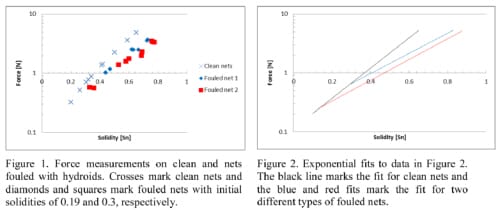In finfish aquaculture, net cages change their shape depending on current velocity, original shape and construction of the cage, type of netting, weight configuration (sinkertube or lump weights), and level of biofouling (e.g. Fredheim, 2005; Lader et al., 2008).
Biofouling increases the net aperture occlusion, thus affecting drag forces on nets and restricting the water flow across the net. Biofouling thereby threatens the stability of fish cages and decreases the cage volume and water quality inside net pens.
The accumulation of biofouling has technical relevance, but it also affects fish welfare. Technical standards such as the Norwegian NS9415 (2009), regulating the use of structural elements of fish cages and farms, acknowledge an effect of the accumulation of biofouling on hydrodynamic loads on fish cages, but they fail to regulate the quantification of this effect.
Fouling related drag increase on nets found by several authors varies strongly, ranging from only minor drag increase to over 12 times higher drag due to the accumulation of marine fouling (e.g. Baldwin et al., 2003; Swift et al., 2006; Milne, 1970). Most studies do not distinguish between different fouling organisms even through different types of fouling will affect drag forces differently.
Today there is still a lack of knowledge on the effect of biofouling buildup on the hydrodynamic properties of fish nets and cages. Numerical models exist to predict the behavior of clean nets and fish cages in waves and currents, but models accurately taking the effects of biofouling into account do not exist.
SINTEF Fisheries and aquaculture has developed a framework for time-domain simulations, FhSim, primarily for simulating marine systems and structures. One of its applications is the simulation of net cages. Two separate formulations for modeling net structures is available, one using triangular elements and one using cable elements. Important net characteristics are mesh size, twine diameter, density and stiffness.
This study investigates the effect of different types and amounts of fouling on nets and builds a database to compare the drag on clean and fouled nets. Based on this type of information guidelines can be developed that set limits for maximum tolerable amounts of fouling on nets to avoid insufficient water exchange inside fish cages.
The database allows a parameterization of the effect of biofouling and gives transfer functions between fouled and clean nets, thus enabling an implementation of biofouling into numerical models developed for clean nets.
Material and methods
Drag forces on clean and fouled nets were measured in a low-turbulence flume tank. The tank was 13 m long, 0.6 m wide and 0.5 m deep. All nets were mounted in a frame by stretching the net over the sides of a rectangular frame and clamping the nets on all sides.
Drag forces on the nets were measured with two strain gauges for 120 seconds with a sampling frequency of 100 Hz. The amount of fouling was determined as solidity as described in Guenther et al. (2010) or as wet weight.
To establish a relationship between net solidity and drag force a number of clean nets was chosen so that a large solidity range was covered. Two types of clean net were chosen and the solidity of these nets was changed with different amounts of fouling. This was done with three different fouling types: hydroids (small, soft organism), blue mussels (small to medium sized, hard fouling organism) and seaweed (large, flexible organism).

Results and discussion
Several factors can influence the flow through nets, but results from this study suggest solidity to be a good proxy for describing a net with respect to drag on nets in currents. Measurements of drag on clean and fouled nets with different solidities are shown in Figure 1. The figure is for hydroid fouling, but data on seaweed and blue mussel fouling is included in the database.
Figure 2 shows exponential fits to the data series. A statistical analysis confirms that the inclination of the fits is different between the clean and fouled net results and that it is not significantly different for fouled nets of different net types. That means that one single function describes the relationship of net solidity and drag for a certain type of fouling as well as for clean nets (at least within the tested solidity range), allowing a description of the effect of biofouling accumulation on nets.
Different fouling organisms influence the solidity/drag relationship differently and lead to different inclinations of linearized fits. Knowing the solidity of a fouled net, the initial solidity of a net before fouling developed, and the type of fouling, the database can be used to find a clean net solidity that experiences the same drag. This clean net solidity can then be used in numerical models to model the effect of biofouling on the behaviour of fish cage nets in currents.
FhSim is an example of a model in which results from the database can be implemented. The hydrodynamic model of FhSim is based on a combination of the relative velocity and orientation of every thread through the water and the solidity of the net material as a whole. The hydrodynamic model will be extended to include the effect of fouling, where the amount of fouling will be represented by a parameter set which is yet to be determined. The hydrodynamic model will then include either a dataset as a basis for interpolation or a parameterized model representing the effects of fouling.




